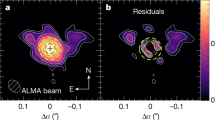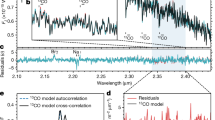Abstract
The observations of three rotational transitions (J = 70 → 69, 71 → 70, and 72 → 71) of HC11N (cyano-deca-penta-yne) in the microwave emission spectrum of the circumstellar envelope of the cool carbon star IRC + 10°216 are reported here. The abundances relative to molecular hydrogen and HC7N are estimated to be ∼7×10−8 and ∼0.7, respectively. With these observations, taken during March and May 1981 at the Haystack Observatory, HC11N becomes the largest and heaviest molecule yet detected outside the Earth's atmosphere.
This is a preview of subscription content, access via your institution
Access options
Subscribe to this journal
Receive 51 print issues and online access
$199.00 per year
only $3.90 per issue
Buy this article
- Purchase on Springer Link
- Instant access to full article PDF
Prices may be subject to local taxes which are calculated during checkout
Similar content being viewed by others
References
Wannier, P. G. et al. Astrophys. J. 230, 149 (1979).
Kwok, S., Bell, M. B. & Feldman, P. A. Astrophys. J. 247, 125 (1981).
Bell, M. B., Kwok, S., Matthews, H. E. & Feldman, P. A. Astr. J. (in the press).
Oka, T. J. molec. Spectr. 72, 172 (1978).
Alexander, A. J., Kroto, H. W. & Walton, D. R. M. J. molec. Spectr. 62, 175 (1976).
Winnewisser, G. & Walmsley, C. M. Astr. Astrophys. 70, L137 (1979).
Bell, M. B. & Seaquist, E. R. Astrophys. J. 238, 818 (1980).
Broten, N. W., Oka, T., Avery, L. W., MacLeod, J. M. & Kroto, H. W. Astrophys. J. Lett. 223, L105 (1978).
Avery, L. W. IAU Symp. No. 87, p. 47 (1980).
Morris, M. Astrophys. J. 197, 603 (1975).
Kwan, J. & Hill, F. Astrophys. J. 215, 781 (1977).
McCabe, E. M., Smith, R. C. & Clegg, R. E. S. Nature 281, 263 (1979).
Bujarrabal, V., Guélin, M., Morris, M. & Thaddeus, P. Astr. Astrophys. 99, 239 (1981).
MacLeod, J. M., Avery, L. W. & Broten, N. W. Astrophys. J. 233, 584 (1979).
Schiff, H. I. & Böhme, D. K. Astrophys. J. 232, 740 (1979).
Mitchell, G. F., Huntress, W. T. & Prasad, S. S. Astrophys. J. 233, 102 (1979).
Churchwell, E., Winnewisser, G. & Walmsley, C. M. Astr. Astrophys. 67, 139 (1978).
Allen, M. & Robinson, G. W. Astrophys. J. 212, 396 (1977).
Tsuji, T. Ann. Tokyo. astr. Obs. 9, 1 (1964).
Kwok, S. Astrophys. J. 198, 583 (1975).
Osterbrock, D. E. Astrophysics of Gaseous Nebulae, 228 (Freeman, San Francisco, 1974).
Author information
Authors and Affiliations
Rights and permissions
About this article
Cite this article
Bell, M., Feldman, P., Kwok, S. et al. Detection of HC11N in IRC + 10°216. Nature 295, 389–391 (1982). https://doi.org/10.1038/295389a0
Received:
Accepted:
Issue Date:
DOI: https://doi.org/10.1038/295389a0
This article is cited by
-
An investigation of spectral line stacking techniques and application to the detection of HC11N
Nature Astronomy (2021)
-
Electronic spectra of the linear cationic chains NC2n N+ (n = 1–7): an ab initio study
Theoretical Chemistry Accounts (2011)
-
Carbynes: Advances in the field of linear carbon chain compounds
Journal of Materials Science (1996)
-
Polyatomic molecules, molecular ions, and radicals of astrophysical interest, II
Astrophysics and Space Science (1989)
Comments
By submitting a comment you agree to abide by our Terms and Community Guidelines. If you find something abusive or that does not comply with our terms or guidelines please flag it as inappropriate.



